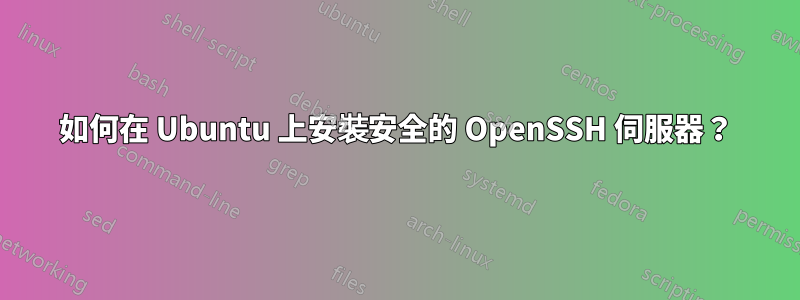
我想在 Ubuntu 上安裝 OpenSSH 伺服器。怎麼做?
我需要執行以下操作:
設定 OpenSSH 伺服器
為用戶設定ssh公私鑰對
停用密碼登入
啟用根用戶
為root用戶設定ssh公私鑰對
設定密碼
答案1
轉到終端機並輸入:
sudo su
aptitude install openssh-server openssh-client
測試安裝
ps -A | grep sshd
如果輸出是這樣的:
<some number> ? 00:00:00 sshd
然後 ssh 守護程式正在運行。
再次輸入終端機;
ss -lnp | grep sshd
如果輸出是這樣的:
0 128 :::22 :::* users:(("sshd",16893,4))
0 128 *:22 *:* users:(("sshd",16893,3))
那麼這意味著 ssh 守護程式正在監聽傳入的連接
現在我們編輯設定檔。首先我們對原始文件進行備份。
sudo cp /etc/ssh/sshd_config /etc/ssh/sshd_config.factory-defaults
現在我們打開設定檔進行編輯
sudo gedit /etc/ssh/sshd_config
弱密碼很容易被猜到。最佳實踐是使用 SSH 金鑰而不是密碼。
所以我們完全禁用密碼驗證。
去排隊
#PasswordAuthentication yes
並將其替換為
PasswordAuthentication no
啟用轉送為已經猜出密碼的攻擊者提供了更多選擇。
所以我們禁用它。它給了我們一點安全感
轉到線路
AllowTcpForwarding yes
X11Forwarding yes
並將它們替換為
AllowTcpForwarding no
X11Forwarding no
我們可以明確允許某些使用者並拒絕某些使用者登入。
為此,我們必須將以下行放在設定檔的底部。
AllowUsers Fred Wilma
DenyUsers Dino Pebbles
為了筆記型電腦的最佳性能,我們允許兩個掛起的連接。在第三個和第十個連接之間,系統將在第十個同時連接時開始隨機丟棄連接,從 30% 到 100%。這可以透過以下行完成
MaxStartups 2:30:10
為了記錄更多錯誤和其他有用信息,我們更改了該行
LogLevel INFO
進入 LogLevel VERBOSE
為了嚇跑新手攻擊者,我們可以顯示一個橫幅我們從行的前面刪除了哈希標籤
#Banner /etc/issue.net
做到這一點
Banner /etc/issue.net
然後我們進入終端機並輸入:
sudo gedit /etc/issue.net
***************************************************************************
NOTICE TO USERS
This computer system is the private property of its owner, whether
individual, corporate or government. It is for authorized use only.
Users (authorized or unauthorized) have no explicit or implicit
expectation of privacy.
Any or all uses of this system and all files on this system may be
intercepted, monitored, recorded, copied, audited, inspected, and
disclosed to your employer, to authorized site, government, and law
enforcement personnel, as well as authorized officials of government
agencies, both domestic and foreign.
By using this system, the user consents to such interception, monitoring,
recording, copying, auditing, inspection, and disclosure at the
discretion of such personnel or officials. Unauthorized or improper use
of this system may result in civil and criminal penalties and
administrative or disciplinary action, as appropriate. By continuing to
use this system you indicate your awareness of and consent to these terms
and conditions of use. LOG OFF IMMEDIATELY if you do not agree to the
conditions stated in this warning.
****************************************************************************
現在我們儲存並關閉設定檔並透過在終端機中輸入以下命令重新啟動 ssh:
systemctl restart ssh
接下來我們設定 SSH 金鑰 有兩對 SSH 金鑰公用和私有。公鑰存在於伺服器中,私鑰存在於個人中如果有人可以將他的私鑰與公鑰匹配,則只有他/她可以登入。此外,可選地,私鑰可以透過密碼保護。
第一步 - 建立 RSA 金鑰對:
輸入終端
ssh-keygen -t rsa -b 4096
這裡我們使用64位元加密以提高安全性
第二步 - 儲存密鑰和密碼:
按照螢幕上的指示操作,提供所需的密鑰儲存位置,建議接受預設值,選擇密碼,提供強密碼,記住它。
螢幕是這樣的:
ssh-keygen -t rsa
Generating public/private rsa key pair.
Enter file in which to save the key (/home/demo/.ssh/id_rsa):
Enter passphrase (empty for no passphrase):
Enter same passphrase again:
Your identification has been saved in /home/demo/.ssh/id_rsa.
Your public key has been saved in /home/demo/.ssh/id_rsa.pub.
The key fingerprint is:
4a:dd:0a:c6:35:4e:3f:ed:27:38:8c:74:44:4d:93:67 demo@a
The key's randomart image is:
+--[ RSA 2048]----+
| .oo. |
| . o.E |
| + . o |
| . = = . |
| = S = . |
| o + = + |
| . o + o . |
| . o |
| |
+-----------------+
第三步 - 複合公鑰:
輸入終端
ssh-copy-id [email protected]
這裡123.45.56.78是伺服器IP位址
如果是本機主機,則為
ssh-copy-id user@localmachinename
螢幕是這樣的
The authenticity of host '12.34.56.78 (12.34.56.78)' can't be established.
RSA key fingerprint is b1:2d:33:67:ce:35:4d:5f:f3:a8:cd:c0:c4:48:86:12.
Are you sure you want to continue connecting (yes/no)? yes
Warning: Permanently added '12.34.56.78' (RSA) to the list of known hosts.
[email protected]'s password:
Now try logging into the machine, with "ssh '[email protected]'", and check in:
~/.ssh/authorized_keys
確保我們沒有添加您不期望的額外密鑰。
現在我們的安裝已經完成了。要登入,我們需要在終端機中輸入:
ssh username@servername
然後,當提示輸入密碼時,我們需要提供它。
現在我們啟用 opessh 伺服器的 root 登入 首先必須啟用 sudo 密碼,因為預設情況下它在 Ubuntu 中是停用的。
為此,我們在終端機中輸入以下內容,螢幕將如下所示:
sudo passwd
[sudo] password for [username]: [Type your user password and press return]
Type new UNIX password: [Type the root password you want]
Retype new UNIX password: [Retype the root password you chosen before]
passwd: password updated successfully
現在我們必須編輯 /etc/sudoers 檔案。
這裡我們使用名為visudo的編輯器
這是因為 visudo 的唯一目的是編輯 sudoes 文件
在 ubuntu 中,預設設定檔是由 nano 編輯器開啟的
若要變更它,請在終端機中鍵入:
sudo update-alternatives --config editor
將出現以下畫面:
There are 4 choices for the alternative editor (providing /usr/bin/editor).
Selection Path Priority Status
------------------------------------------------------------
* 0 /bin/nano 40 auto mode
1 /bin/ed -100 manual mode
2 /bin/nano 40 manual mode
3 /usr/bin/vim.basic 30 manual mode
4 /usr/bin/vim.tiny 10 manual mode
Press <enter> to keep the current choice[*], or type selection number:
輸入 3 並按 Enter 鍵
然後輸入:
sudo visudo
移至顯示以下內容的行
Defaults env_reset
按回車鍵
在上面建立一個新行
類型:
預設 rootpw
使用空白鍵,而不是 TAB
按 Esc --> :x --> Enter
在終端類型中:
gedit /etc/ssh/sshd_config
移至行:
PermitRootLogin password-prohibited
並將其更改為
PermitRootLogin yes
接下來移動到該行:
PasswordAuthentication no
並將其更改為
PasswordAuthentication yes
儲存並關閉
然後重新啟動SSH
service ssh restart
現在是時候再次為使用者 root 產生 ssh 公私金鑰對了。
輸入終端
ssh-keygen -t rsa -b 4096
第二步 - 儲存密鑰和密碼:
按照螢幕上的說明進行操作,提供所需的密鑰儲存位置,不要接受預設值,因為這次您必須創建新的對,預設值已經創建,選擇密碼,提供強密碼,記住它。
螢幕是這樣的:
ssh-keygen -t rsa
Generating public/private rsa key pair.
Enter file in which to save the key (/home/demo/.ssh/id_rsa): u-root-id_rsa
Enter passphrase (empty for no passphrase):
Enter same passphrase again:
Your identification has been saved in /home/demo/.ssh/u-root-id_rsa.
Your public key has been saved in /home/demo/.ssh/u-root-id_rsa.pub.
The key fingerprint is:
4a:dd:0a:c6:35:4e:3f:ed:27:38:8c:74:44:4d:93:67 demo@a
The key's randomart image is:
+--[ RSA 2048]----+
| .oo. |
| . o.E |
| + . o |
| . = = . |
| = S = . |
| o + = + |
| . o + o . |
| . o |
| |
+-----------------+
然後在終端機輸入:
ssh-copy-id -i u-root-id_rsa.pub root@localmachinename
輸出螢幕可能會顯示:
The authenticity of host '12.34.56.78 (12.34.56.78)' can't be established.
RSA key fingerprint is b1:2d:33:67:ce:35:4d:5f:f3:a8:cd:c0:c4:48:86:12.
Are you sure you want to continue connecting (yes/no)? yes
Warning: Permanently added '12.34.56.78' (RSA) to the list of known hosts.
[email protected]'s password:
現在嘗試使用“ssh '登入機器[電子郵件受保護]'”,然後簽入:
~/.ssh/authorized_keys
確保我們沒有添加您不期望的額外密鑰。
現在我們已經授予 root 私鑰存取權限來登入
要測試類型:
ssh root@localmachine
再次在終端機類型中:
gedit /etc/ssh/sshd_config
移動到該行:
PasswordAuthentication yes
並將其更改為
PasswordAuthentication no
儲存並關閉
然後重新啟動SSH
service ssh restart
它會要求輸入密碼。密碼不變。給吧。
現在root就可以成功登入了
現在為了提高安全性,我們必須添加防火牆
類型:
apt install ufw
現在開始吧
enable ufw
取得目前正在運行的進程列表
ufw app list
OpenSSH 將會列在那裡。
ALow it through firewall
ufw allow OpenSSH
重新啟動防火牆
systemctl restart ufw
我們的安裝完成了


